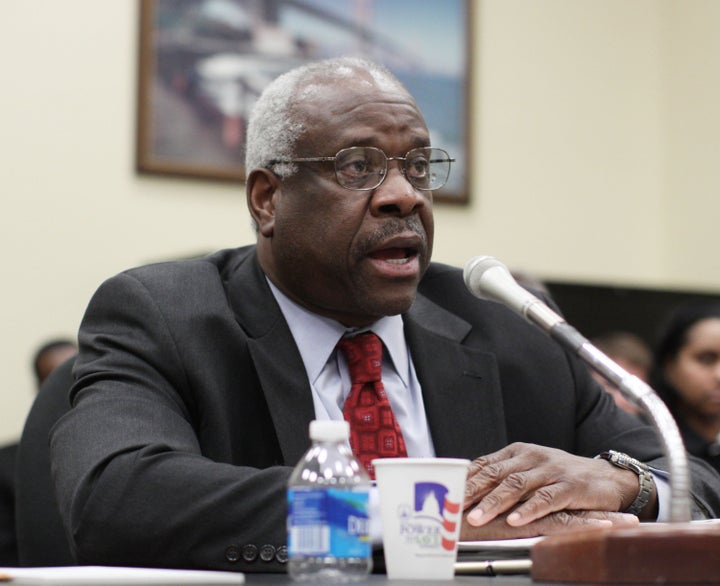
As the Occupy Wall Street movement grows in size and intensity by the day, it's worth noting that Saturday marks the twentieth anniversary of the confirmation of Clarence Thomas as an associate justice on the United States Supreme Court. In our view, one has led directly to the other.
Since he took his seat in 1991, Justice Thomas has become the almost perfect distillation of the ultra-conservative agenda -- the pointy end of the spear of corporatism and social conservatism on the Supreme Court. Jeffrey Toobin, in a recent article in The New Yorker, called him "probably the most conservative Justice to serve on the Court since the nineteen-thirties," whose "views both reflect and inspire the Tea Party movement."
Of course, Clarence Thomas isn't the only conservative on the Corporate Court. There is now a solid five-vote majority for limiting access to the courts, protecting business interests, shifting political power to corporations and weakening the ability of government and citizens to protect the public welfare. But Thomas has become an unquestioned leader of a movement whose agenda is to shift political, legal, and economic power, as well as control over democratic institutions, from everyday Americans to the powerful, the wealthy, and corporations. Those outcomes, part and parcel of the judicial philosophy advanced by Thomas and the other conservative justices, are why people are now taking to the streets by the tens of thousands in cities across the country -- and, indeed, the world.
After observing Clarence Thomas for 20 years, it's clear that his approach to his job really is unique in the history of the Court. His almost absolute silence during oral arguments is notorious, but even more consequential is his extreme originalist judicial philosophy that goes beyond the views of even the most conservative of his colleagues. Most troubling, though, is that he operates in a way that challenges some of the Court's most important traditions and ethical principles, which are at the heart of the notions of judicial independence and impartiality. The legitimacy of the Court rests on the idea that everyone who enters its hallowed chamber has a fair shot at justice and that the outcome isn't pre-cooked or determined by a political agenda being advanced by those hearing the case. Clarence Thomas' behavior threatens that ideal, and by extension, the reputation of the institution.
In that vein, much has been made about the unprecedented involvement of Justice Thomas' wife, Ginni, in the broader conservative movement. The Thomases serve as a kind of conservative tag-team, she on the outside and he on the inside, working toward the same goal -- a fact that they don't attempt to conceal.
When Justice Thomas attended a Federalist Society event at the University of Virginia School of Law in February, he praised his wife's Tea Party activism, saying that she "started her organization [Liberty Central] to give 24/7 every day in defense of liberty." While Mrs. Thomas looked on from the audience, he pulled back the curtain on the truth of his position in the broader conservative movement, when he said that he and Ginni "are equally yoked ... We believe in the same things... So, with my wife, and with the people around me, what I see, I'm reinforced that we are focused on defending liberty."
It has been 20 years since the Senate vote that put Clarence Thomas on the bench and helped ensure that our legal system and the law itself would be placed in the service of the one percent at the expense of the 99 percent. I assume that when the Occupy Wall Street protesters visualize the people who have distorted our system to benefit corporate interests they probably don't picture Supreme Court justices. But maybe they should. Clarence Thomas' influence these last two decades is a reminder that our courts matter, and so do the people who sit on them, a fact that the conservative movement has known all along. After all, that's why he's there.
But perhaps, thanks to OWS and the spirited movement that is now coming into being, we can soon celebrate a different kind of anniversary at this time of year -- the reawakening of an effort to recapture the law and the courts for all Americans, not just the powerful few.
